World Book Fair, 6-14 January 2018
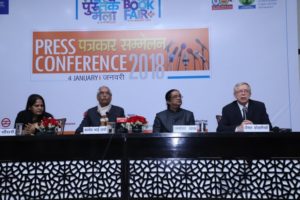
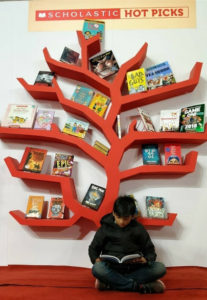 Ever since the World Book Fair moved to January instead of the second week of February there has been a tremendous growth in the number of visitors. Year-on-year there are long queues of people waiting patiently to enter the enter the fair grounds at Pragati Maidan. This year the fair was held in only a small area of the exhibition grounds as much of Pragati Maidan has been demolished. It will be a few years before the new buildings are built. Meanwhile the publishers were placed in some halls and tents. The visitors to the fair walked alongside workers in hard hats and enormous Caterpillar diggers shovelling earth to create mountains taller than the exhibition halls. There were potholes in the roads and a general mess everywhere. Yet it did not
Ever since the World Book Fair moved to January instead of the second week of February there has been a tremendous growth in the number of visitors. Year-on-year there are long queues of people waiting patiently to enter the enter the fair grounds at Pragati Maidan. This year the fair was held in only a small area of the exhibition grounds as much of Pragati Maidan has been demolished. It will be a few years before the new buildings are built. Meanwhile the publishers were placed in some halls and tents. The visitors to the fair walked alongside workers in hard hats and enormous Caterpillar diggers shovelling earth to create mountains taller than the exhibition halls. There were potholes in the roads and a general mess everywhere. Yet it did not 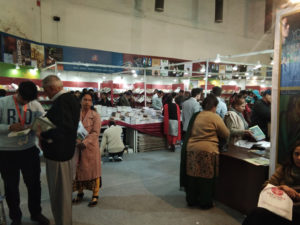 seem to dampen anyone’s enthusiasm to buy books. As in previous years there were buyers trailing suitcases
seem to dampen anyone’s enthusiasm to buy books. As in previous years there were buyers trailing suitcases 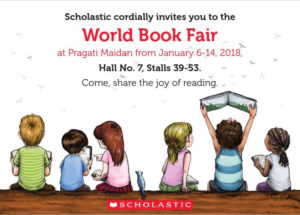 on wheels to pack in the books they would buy. In fact a senior publisher I met during the fair said that the shift to January has been a boon for them as their sales grow better and better with every year.
on wheels to pack in the books they would buy. In fact a senior publisher I met during the fair said that the shift to January has been a boon for them as their sales grow better and better with every year.
The World Book Fair is organised by the National Book Trust. It began in the early 1970s when it was a bi-annual affair before being made an annual feature. It began with the intention of making books accessible and popularising reading. Over the years it has slowly acquired some characteristics of a trade fair with its specific 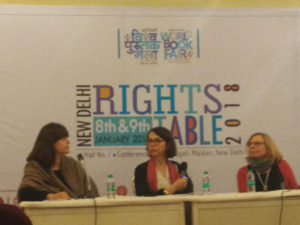
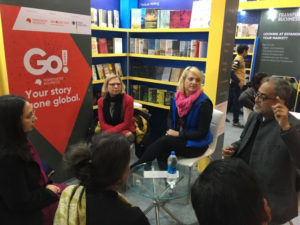 B2B meetings, a Rights Table, panel discussions, an increasing number of international visitors etc. This year the guest of honour was the European Union. The business collaborations that happen unexpectedly at the fair are incredible. Such as this of third-generation publisher Raphael Israel. An Indian Jew who met his Palestinian clients at the fair couple of years. It is now one of the happiest business relationships!
B2B meetings, a Rights Table, panel discussions, an increasing number of international visitors etc. This year the guest of honour was the European Union. The business collaborations that happen unexpectedly at the fair are incredible. Such as this of third-generation publisher Raphael Israel. An Indian Jew who met his Palestinian clients at the fair couple of years. It is now one of the happiest business relationships! 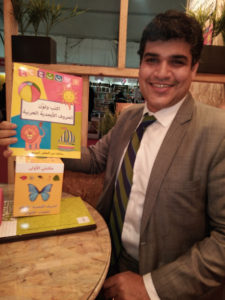
Yet at the heart of it the book fair remains a B2C fair with visitors coming from around the country to buy books. In India there are bookshops but not enough to cater to the vast multi-lingual population. The presence of online retailers over the past few years has helped foster the reading habit among many especially in tier-2 and tier-3 towns. 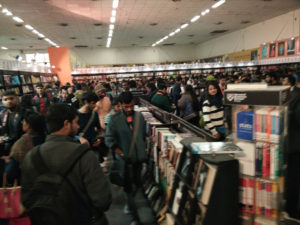 This was a sentiment expressed by many publishers participating in the fair. This time there were definitely larger number of
This was a sentiment expressed by many publishers participating in the fair. This time there were definitely larger number of 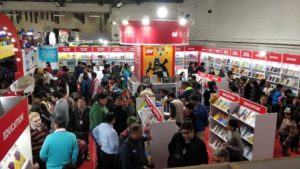 customers many of whom were browsing through the shelves to discover more for themselves. While browsing online is convenient and helpful, algorithm driven searches do not necessarily help in discovering a variety of books for the readers. This is where the display cases at fairs and bookshops help tremendously.
customers many of whom were browsing through the shelves to discover more for themselves. While browsing online is convenient and helpful, algorithm driven searches do not necessarily help in discovering a variety of books for the readers. This is where the display cases at fairs and bookshops help tremendously.
There were visitors of all ages and even people using walking sticks or in wheel chairs braving the potholes and dust swirling around. It did help greatly that the winter break of schools had been extended due to the excessive chill. So families came to spend their day at the book fair, browsing, buying and having a picnic. Surprisingly the crowds came even during the designated business hours so that by the afternoon it was impossible to walk through the crush of people. Over the weekends the crowds were incredible. Publishers of children’s and young adult literature were delighted with the response. Sales were unprecedented for many whereas others managed to break even. Comments such as this were often overheard: Child telling parent “Don’t say you will 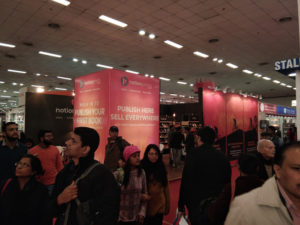 buy the book online. Buy it now!” Sales of the trade and academic
buy the book online. Buy it now!” Sales of the trade and academic 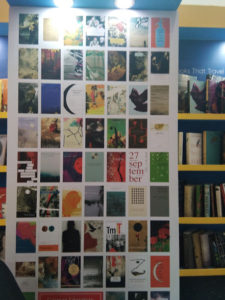 publishers were brisk as well but some reported poorer sales than last year citing the poor location as the major reason for lack of visitors. The Hindi publishers were satisfied with the response with some saying that the usual growth of sales of 15-20% which is commensurate with the growth of their publishing y-o-y was evident. Interestingly enough this year there was a significant presence of self-publishers. Sadly though this year there was a very low turnout of Indian regional language publishers. Curiously enough the stalls of the few who participated such as the Bengali, Marathi and
publishers were brisk as well but some reported poorer sales than last year citing the poor location as the major reason for lack of visitors. The Hindi publishers were satisfied with the response with some saying that the usual growth of sales of 15-20% which is commensurate with the growth of their publishing y-o-y was evident. Interestingly enough this year there was a significant presence of self-publishers. Sadly though this year there was a very low turnout of Indian regional language publishers. Curiously enough the stalls of the few who participated such as the Bengali, Marathi and 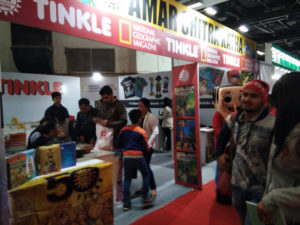 Urdu publishers, their signboards were written in Hindi!
Urdu publishers, their signboards were written in Hindi!
This was the first time that audio books made their presence felt. For example, the Swedish firm Storytel is 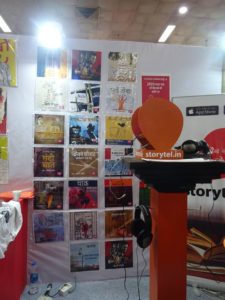 partnering with publishers in Hindi, English and Marathi. An audio tower had been placed in the stall of Hindi publishers, Rajkamal Prakashan, where 60 audio books could be sampled. Apart from this there was evidence of newcomers who had put up stalls showcasing their storytelling websites/apps/storycards that had a digital audio version too. These were individual efforts. It was also rumoured that other bigger players could be expected to make an entrance into the Indian publishing ecosystem. Perhaps they will announce their presence at the next world book fair, January 2019?
partnering with publishers in Hindi, English and Marathi. An audio tower had been placed in the stall of Hindi publishers, Rajkamal Prakashan, where 60 audio books could be sampled. Apart from this there was evidence of newcomers who had put up stalls showcasing their storytelling websites/apps/storycards that had a digital audio version too. These were individual efforts. It was also rumoured that other bigger players could be expected to make an entrance into the Indian publishing ecosystem. Perhaps they will announce their presence at the next world book fair, January 2019?
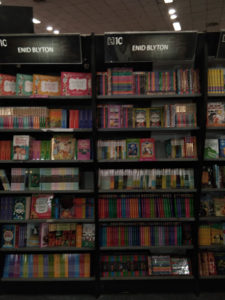 Undoubtedly the local book market is growing as there are still many first generation buyers of books in India. Despite the vast variety of books on display it was the backlist of most publishers which was moving rapidly. Pan Macmillan India for instance had a corner dedicated to their Macmillan
Undoubtedly the local book market is growing as there are still many first generation buyers of books in India. Despite the vast variety of books on display it was the backlist of most publishers which was moving rapidly. Pan Macmillan India for instance had a corner dedicated to their Macmillan 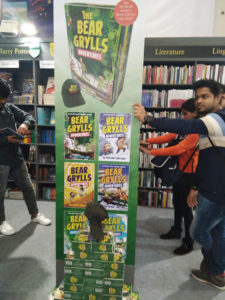 Classics that were very popular. Interestingly the branded authors such as Enid Blyton, Bear Grylls and J. K. Rowling had entire shelves dedicated to their works. At a time when most authors are jostling for space to be seen and heard, these generous displays by publishers for a single author were a testimony to the significance and influence they wield with readers. Obviously the long tail of backlists are good business. Repro is collaborating with Ingram to offer Print On Demand ( POD) services. These work well for those with
Classics that were very popular. Interestingly the branded authors such as Enid Blyton, Bear Grylls and J. K. Rowling had entire shelves dedicated to their works. At a time when most authors are jostling for space to be seen and heard, these generous displays by publishers for a single author were a testimony to the significance and influence they wield with readers. Obviously the long tail of backlists are good business. Repro is collaborating with Ingram to offer Print On Demand ( POD) services. These work well for those with 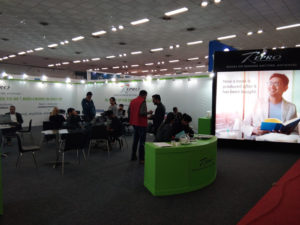 significant backlists that need to be kept alive for customers but to avoid excessive warehousing costs and tying up cash in stock, it is best to offer POD services to customers. The demand for a backlist title of a specific publishing house is fulfilled by vendors who use the marketplaces offered by online retailers. The cost of the title purchased is higher than if it had been part of a print run but this arrangement works favourably for everyone concerned.
significant backlists that need to be kept alive for customers but to avoid excessive warehousing costs and tying up cash in stock, it is best to offer POD services to customers. The demand for a backlist title of a specific publishing house is fulfilled by vendors who use the marketplaces offered by online retailers. The cost of the title purchased is higher than if it had been part of a print run but this arrangement works favourably for everyone concerned.
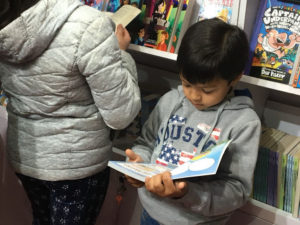 While browsing through the bookshelves it was not uncommon to notice readers
While browsing through the bookshelves it was not uncommon to notice readers 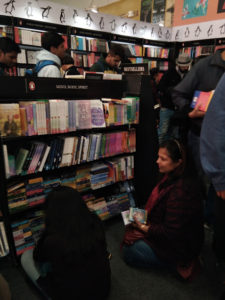 either standing absorbed in reading or sitting peacefully crosslegged on the floor reading through the books they had shortlisted. What was remarkable was how serenely they sat despite the crowds milling around them. If there were displays on tables as at the DK India stall and the regional language stalls, people were standing and reading calmly.
either standing absorbed in reading or sitting peacefully crosslegged on the floor reading through the books they had shortlisted. What was remarkable was how serenely they sat despite the crowds milling around them. If there were displays on tables as at the DK India stall and the regional language stalls, people were standing and reading calmly. 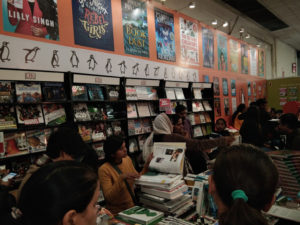
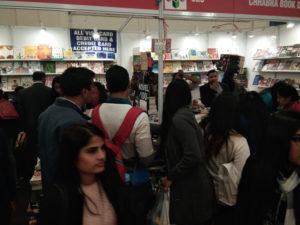
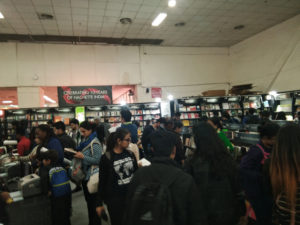 Happily a large number of younger customers thronged the fair and buying. Even though some publishers said that few people haggled for discounts the crowds at the secondhand and remaindered stalls had to be seen. There was such a melee. Books were being sold for as little as 3 for Rs 100! While publishers were not amused at the presence of these remaindered stalls doing brisk business, customers were delighted that for a small amount of money they could buy a pile of books.
Happily a large number of younger customers thronged the fair and buying. Even though some publishers said that few people haggled for discounts the crowds at the secondhand and remaindered stalls had to be seen. There was such a melee. Books were being sold for as little as 3 for Rs 100! While publishers were not amused at the presence of these remaindered stalls doing brisk business, customers were delighted that for a small amount of money they could buy a pile of books.
All said and done it was a satisfying book fair. Hats off to the National Book Trust team for running it so smoothly and efficiently every year!
30 January 2018

No Comments